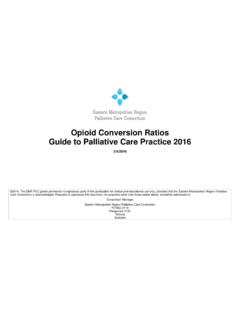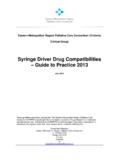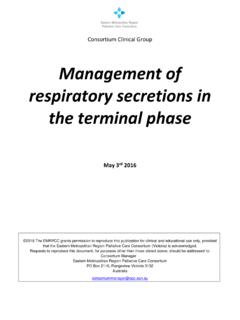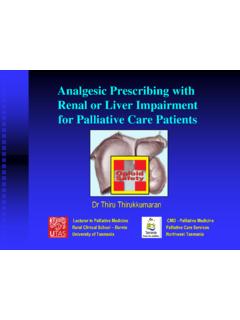Transcription of Syringe Driver Drug Compatibilities Guide to …
1 Eastern Metropolitan Region palliative care Consortium (Victoria) Syringe Driver drug Compatibilities Guide to palliative care Practice 2016 3/5/2016 INSTRUCTIONS FOR USE It is highly recommended this Guide is used electronically or printed in colour, to aid ease of use. Page 2 of 21 Contents DISCLAIMER .. 3 IMPORTANT CONSIDERATIONS .. 3 KEY .. 3 Compatibility .. 4 Infusion site problems .. 4 Syringe Driver Information .. 4 Clonazepam .. 5 Cyclizine .. 6 Fentanyl .. 8 Glycopyrronium .. 9 Haloperidol .. 10 Hydromorphone.
2 12 Hyoscine Butylbromide (Hyoscine BBr) .. 13 Ketamine .. 14 Ketorolac .. 15 Levomepromazine .. 15 Lidocaine .. 17 Methadone .. 17 Metoclopramide .. 17 Midazolam .. 18 Morphine Sulfate .. 19 Morphine Tartrate .. 19 Octreotide .. 19 Olanzapine .. 19 Ondansetron .. 19 Oxycodone .. 19 Phenobarbital .. 20 Ranitidine .. 20 Sufentanil .. 20 REFERENCES .. 21 Acknowledgements .. 21 2016. The Eastern Metropolitan Region palliative care Consortium (EMRPCC) grants permission to reproduce this publication for clinical and educational use, provided that the EMRPCC is acknowledged.
3 Requests to reproduce this document, for purposes other than those stated, should be addressed to: Consortium Manager Eastern Metropolitan Region palliative care Consortium c/- PO Box 2110 Rangeview 3132 Victoria, Australia or Name used in this document Full title Previously called Glycopyrronium Glycopyrronium bromide (glycopyrrolate) Glycopyrrolate Lidocaine Lidocaine (lignocaine) hydrochloride Lignocaine hydrochloride anhydrous Phenobarbitone Phenobarbital (phenobarbitone) sodium Phenobarbitone sodium Eastern Metropolitan Region palliative care Consortium Clinical Group 2016 Page 3 of 21 DISCLAIMER The information in this palliative care document is intended as a Guide only.
4 It is the responsibility of the user to ensure information is used correctly. This Guide reflects adult palliative care practice in Victoria and is based on evidence at the time of review. All drug compatibility combinations derived from this Guide should be checked and prescribed by a medical doctor or nurse practitioner with appropriate experience before administering. In accordance with quality practice, this Guide should be submitted for organisational approval prior to use. When setting up and using Syringe drivers , follow organisational policy and procedures. IMPORTANT CONSIDERATIONS It is recommended that the number of drugs in one Syringe be limited to three.
5 Caution should be used when combining drugs in Syringe drivers ; mixtures should be closely monitored for discolouration, precipitation and crystallisation. Infusion durations in this Guide are for 24 hours. Sodium chloride is the diluent used in this Guide , except where stated. Subcutaneous administration of a drug may be off-label prescribing drug doses should be modified in response to the adult patient/client s clinical situation and status, including previous exposure to opioids and concurrent medications. All patients should be monitored closely when commencing and/or switching opioid medications.
6 If you require further information regarding drug combinations and compatibility data, contact a hospital-based pharmacy drug information service working with a specialist palliative care service. KEY Instructions for reading the list of drugs All drugs are listed in alphabetical order. When searching for drug combinations, search by the drug which occurs first alphabetically. drug combinations are not repeated in reverse order Example: Haloperidol Haloperidol, Hydromorphone Haloperidol, Hydromorphone, Metoclopramide Symbol Explanation Appears compatible.
7 Information is gathered from the clinical setting based on observation of the drug combination on mixing and during infusion for any physical changes, precipitation, discolouration or clouding. The information is not validated evidence based research. Compatibility information available based on laboratory data A A = Chemically Compatible. Compatibility data obtained by laboratory analysis in the stated drug combination, in the usual diluent and over a range of temperatures. B B = Physically Compatible. The lack of physical change such as discoloration, clouding or crystallization tested microscopically or by laboratory analysis.
8 C C = potential for site reaction. See Infusion site problems Conflicting information regarding compatibility proceed with caution Caution can apply to clinical and evidence based compatibility reports Incompatible WFI Water for Injection Eastern Metropolitan Region palliative care Consortium Clinical Group 2016 Page 4 of 21 Compatibility Compatibility is dependent on the concentration of each drug in the total final volume being infused, rather than the actual dose. Numerous factors effect stability and compatibility including drug salt, strength, diluents, order of drawing up, temperature and infusion periods.
9 In this Guide , infusion durations are for 24 hours. Monitoring of the combined drugs in the Syringe Driver throughout the infusion period is advised. Sodium chloride is the diluent used routinely in Victorian practice, except for cyclizine which is diluted with Water for Injection. Sodium Chloride is used as the diluent throughout this Guide , unless otherwise stated. When combining medications for Syringe Driver use, be aware that laboratory compatibility data is available for only a few drug combinations. As a consequence, the majority of combinations listed in this Guide are observational data.
10 If the combination is not listed in this practice guideline, consult 1. Dickman A, Schneider J. The Syringe Driver Continuous subcutaneous infusions in palliative care . 3rd ed. Oxford: Oxford University Press; 20111 2. The Syringe Driver database on the palliative care website 2 The Syringe drive database available at can be accessed after registration. Combinations on the database have been assessed by pharmacists. The information is not substantiated but is observational data. The database may contain information not included in this document. The database states that drugs may be compatible at certain concentrations and not at others, therefore it is recommended that the concentration of drug in solution is compared, not the dose 2 Infusion site problems A plastic (Teflon or Vialon ) cannula should be used rather than a metal butterfly needle to reduce site inflammation.






![[P] Clonazepam - Palliative Care](/cache/preview/7/3/1/8/c/1/0/f/thumb-7318c10f561f7c7ba618d52f79801a4d.jpg)






